Thoughts from the Global Maritime Forum – Martin Crawford-Brunt, CEO

The Global Maritime Forum Annual Summit has evolved into a unique event, attended by 250 of maritime’s top CEOs and leaders, all focused on the same goal: improving our industry.
While many topics were covered, the “Safety Together” session in particular resonated with me. Since stepping into the role of CEO at RightShip, I’ve felt the weight and responsibility of ensuring RightShip utilises our position in the industry to facilitate continuous improvement in maritime safety.
All leadership teams in our industry are responsible for ensuring their company’s safety culture is understood and embodied by everyone. This requires clear messages of support, examples and stories to ensure all employees feel empowered to intervene should unsafe conditions be observed. In addition, safety-related metrics and KPIs should be linked to the remuneration of all senior managers to ensure the focus on safety is maintained from the top.
While it is important to effect change from the top, we also need to ensure seafarers, the ultimate beneficiaries, have a voice in safety. More is normally not always better when it comes to safety; experience shows simple and clear works best. Therefore seafarers should be directly involved in the establishment of new processes and procedures to improve outcomes.
We also need to ensure that seafarer welfare is considered important and provided onboard to reduce accidents and suicides. RightShip pledges to support seafarer welfare through advocating for fair treatment of crew after incidents, providing voluntary welfare inspection programs and supporting leading seafarer charities.
We must bring both sides together and keep the score by sharing all accident statistics and make sure they are acted upon. RightShip recognises there is real room for improvement in this area, and we should not accept poor reporting following casualties. As an industry we need to gather all cases to make it visible and hold those responsible to account.
Therefore, RightShip will work towards collecting and clearly displaying more data on the Qi platform, as well as in depth analytics to reward good behaviour and outcomes while flagging accidents, incidents and detentions.
A final method of ensuring we can reach the highest safety standards will be through sharing lessons learned and success stories to ensure it is understood that dramatic improvement is achievable with the right focus.
We acknowledge that we need to support our industry’s best participants by measuring and recognising operational excellence, requiring root cause analysis on all major incidents before restoring the risk rating and publishing lessons learned. By bringing these targets to the RightShip team, we will continue to focus on improving RightShip’s standards, as well as those that are evident in the wider industry.
It was an invigorating three days, and all participants left feeling inspired to create the change required in our organisations over the next 12 months. However, change is coming and there will be hard work ahead for all of us in the industry.
Martin Crawford-Brunt (CEO, RightShip)